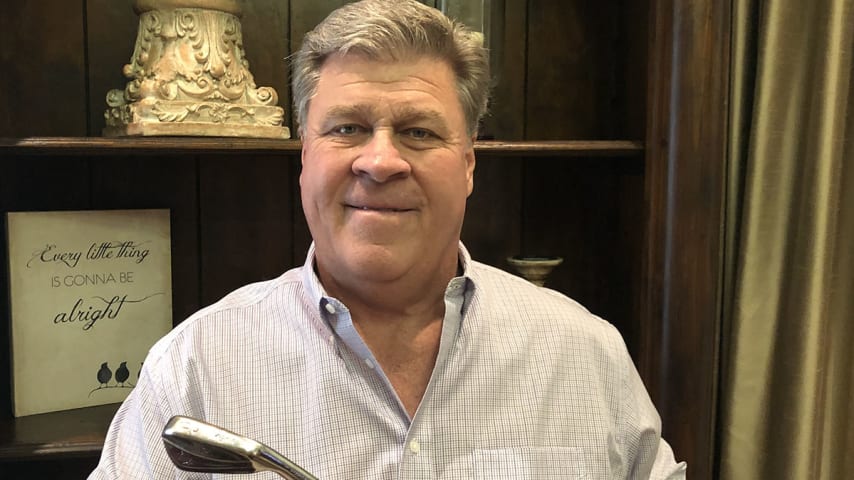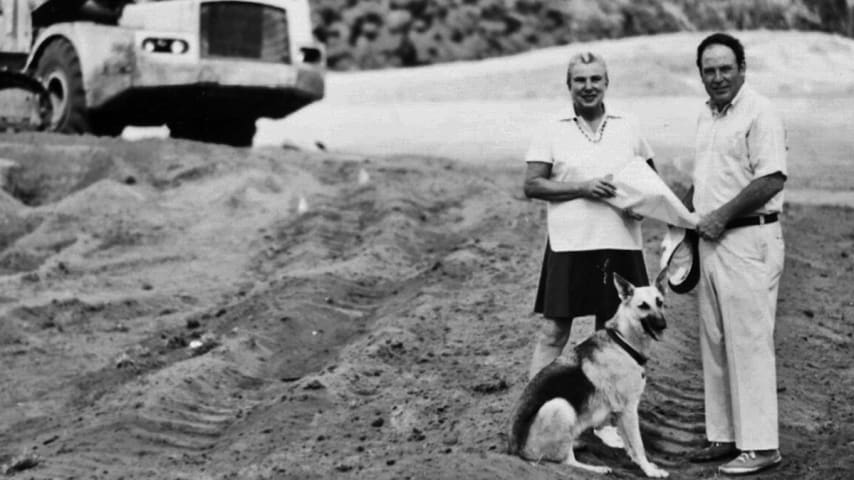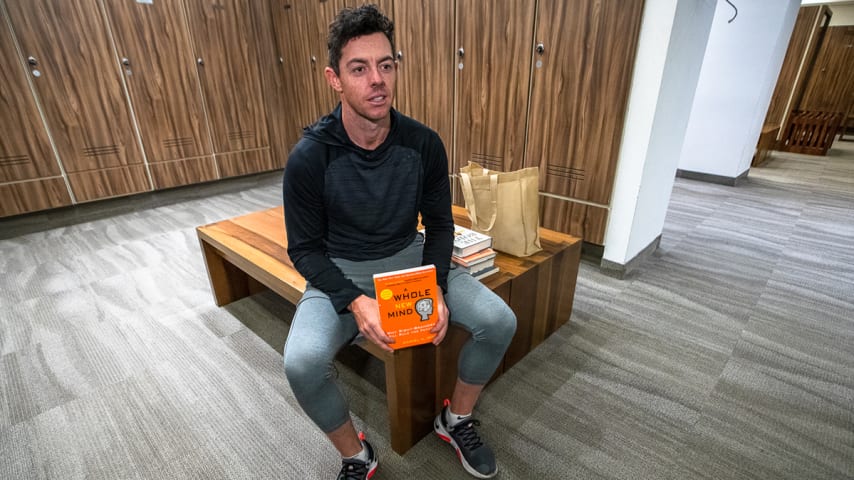Where is Hal Sutton's 'right club' today?
13 Min Read

Hal Sutton’s celebrated 6-iron is within arm’s reach, a reminder of his historic PLAYERS victory 20 years ago
Written by Mike McAllister
Hal Sutton’s celebrated 6-iron is within arm’s reach, a reminder of his historic PLAYERS victory 20 years ago
The right club can be found in the trophy case in the den of Hal Sutton’s house in Houston, resting among the other clubs used to win THE PLAYERS Championship in 2000. Actually, there is one club missing from that set – the putter, which Sutton buried in a time capsule at Boot Ranch just north of Fredericksburg.
Asked recently for the specifics of the right club, Sutton walked over to his trophy case and took it out of the bag. “It has my initials on the back,” he observes. “Yeah, it’s a Hogan X100.”
The right club is the most famous piece of equipment in the history of THE PLAYERS Championship. It’s the 6-iron that Sutton used on his approach shot at the 18th hole in the final round as he was trying to hold off world No. 1 Tiger Woods and win THE PLAYERS for the second time in his career. From the fairway, 178 yards from the pin, Sutton – leading Woods by a single stroke at the time -- struck what he hoped to be the clinching shot.
As he watched the ball in flight, Sutton, in his Louisiana southern accent, then uttered the most famous phrase from any golfer playing the Stadium Course at TPC Sawgrass.
Be the right club TODAY.
It was, of course. The ball landed 8 feet from the pin, setting up an easy two-putt par for the win. That’s why the club – and Sutton’s unscripted reaction – have gone down in PLAYERS lore. That’s why the shot might be the greatest shot in PLAYERS history. “It’s certainly the greatest shot in Hal Sutton’s history,” he admits.
That’s why, 20 years later, Sutton still hears fans shout the phrase to him when they see him, usually in the airport or at functions that he attends. They see him, sometimes at a considerable distance, and can’t help themselves. It’s a compulsion, really. They have to say it to him.
Be the right club TODAY.
Sutton recalls one time – he thinks it was at a golf tournament, certainly some type of golf environment – he heard the phrase uttered 36 times. That’s the number he counted, although he admits it’s a guess. “It was one of those days when it seems like everybody was talking to you,” he says.
Be the right club TODAY.
The club, that specific 6-iron, had been in Sutton’s bag for little more than a year. Sutton generally changed equipment every two years, and the clubs he used in 2000 were on their second year. They had treated him well – he won in Canada in 1999 with them, and after THE PLAYERS win, he would also claim victory later that year in Greensboro, North Carolina. The right club – and its brothers – had been successful more than just that particular Monday when the final round was concluded.
Be the right club TODAY.
Sutton had never uttered the phrase before he said it on the 72nd hole at TPC Sawgrass. In fact, he’d never heard anybody else utter it, either. And he certainly never uttered it again while playing golf. It was a one-time thing. He calls it a “moment of passion.”
Frankly, to say it again would’ve seemed blasphemous … or certainly forced. This was organic. Not only was it the right club, it was the right moment. The right shot. The right setting. And frankly, the right winner on the right course – a straight-shooting 41-year-old, who might not have been able to match Tiger’s athletic skills on a bomber’s course but could go toe-to-toe with him on a Pete Dye gem that favors all shot-making skills, not simply length off the tee.
It also tests a player’s true grit. Sutton had that in spades.
Be the right club TODAY.
This was not fate. It was pure skill, a fiery competitive spirit, and the ultimate lesson in knowing one’s golf game.
Sutton went to bed that Saturday night in March of 2000 and, as usual, said his prayers.
He was the 54-hole leader at THE PLAYERS, with a score of 9 under – one shot ahead of his Sunday playing partner Woods. Given that Woods already had won three times in a year that would eventually include nine PGA TOUR victories, including wins in the last three majors of the season, it was a precarious spot for Sutton.
No wonder that most observers considered it a fait accompli that Woods would overtake Sutton that Sunday to win THE PLAYERS. Woods entered that week as the world No. 1 by a ridiculous 10-point margin over No. 2 David Duval. Sutton was no slouch – he was ranked 11th – but he knew what they were saying through three rounds.
He was the leader, but this was Woods’ tournament to win or lose.
Perhaps people forgot that Sutton knew how to successfully stare down legends. Seventeen years earlier, at the 1983 PGA Championship, a 24-year-old Sutton had gone wire-to-wire to win at Riviera – another shot-maker’s course, if you’re wondering. The runner-up was a hard-charging Jack Nicklaus, who shot 66 in the final round to Sutton’s 71. Sutton won $100,000 that week – it was the first six-figure winner’s share in any major.
Oh, and about four months earlier, Sutton had won his first PLAYERS Championship, being held at its new permanent course, TPC Sawgrass, for just the second time.
Sutton, though, knew that beating a 24-year-old Woods would be tougher than beating a 43-year-old Nicklaus.
“Jack was the greatest player ever, but he was 43 years old at the time,” Sutton said. “He was playing good. While he wasn’t tip-toeing going over the edge, he had his best behind him.
“In Tiger’s case, he was climbing fast and furious. The media said no one in the world could beat him and were emphatic that I was supposed to shrink. I was actually agitated by that.”
In another perhaps-they-forgot moment, Sutton already had dealt with Woods earlier that year. They were paired for the first two rounds at, ironically enough, Riviera at the then-Nissan Open [now The Genesis Invitational run by Woods’ Foundation]. Sutton shot 69-67, Woods shot 68-70; the third member of that group, Steve Pate, shot 71-70. Sutton was T-7 entering the weekend before fading, but if nothing else, he showed he could hold his own against the world’s best golfer on a course that rewarded precision more than muscle. He had, in his own words, “sent a message.”
Woods, of course, wasn’t biting when asked about the Riviera effect. “He is obviously looking at L.A. as a positive for himself, and that is probably the smart thing to do,” Woods told the media. “If I was in the same position, I probably wouldn't look at it that way, because I finished 18th. I don't know if you can look at that as being a very positive finish.”
Even so, Sutton said his prayers that night in Northeast Florida.
“When I knelt down, I wasn’t kneeling down to pray to Tiger Woods,” Sutton says. “That means he’s just a man, just like me. So I figured we’d just settle it tomorrow.
“And I knew that on that golf course, I could beat him because his power wasn’t going to take command there. He had to play from Point A to Point B to Point C, just like I did. I said, OK, let’s go do that because I think I’m pretty darn good at that.
“I sincerely in my heart believed I could beat him there – and I wasn’t going to allow the world to tell me I couldn’t.”
Even so, there’s no doubt that Sutton faced a monumental task. As his longtime caddie, Freddie Burns, recalled in a first-person account for Sports Illustrated: “When you've got Tiger on your ass, the way we did at THE PLAYERS Championship, it's the worst kind of pressure. It's like somebody putting 300 pounds on you and all you can lift is 285.”
The world definitely was wrong on Sunday. After parring the first 10 holes, the steady Sutton increased his lead over Woods with a, 25-foot birdie putt at the 11th moving him three ahead. The key shot that day, from Sutton’s perspective, was at the par-3 eighth.
After finding the back-left bunker with his tee shot, Sutton was left with a tricky second. He couldn’t stand in the bunker to hit his shot, and the ball was below his feet. After making contact, Sutton lost his balance and nearly fell into the sand. Yet he managed to blast out to 10 feet, then converted the putt to keep his string of pars intact.
“That was a great shot he played out of there,” Woods said later. “… You can tell any good bunker player, there is a certain sound that is made and you can hear that little spank sound that he made, a little thump. And it came out beautifully with some spin, and he made a great putt there. Putt broke, probably -- looked like from my angle a good 6 to 8 inches, and he poured it right in the middle.”
Twenty years later, Sutton put it in perspective. “In all honesty that was the shot that won the tournament,” he admits. “It doesn’t get talked about a lot … but it kept the momentum going.”
Be the right sand wedge TODAY – alas, it just doesn’t have the same punch.
On the next hole after Sutton’s long birdie putt, heavy rains soaked TPC Sawgrass, forcing a postponement of play until Monday. Sutton would get one more chance to pray.
Back in action on Monday, Woods dropped four back after three-putting the 12th. Then he woke up. A birdie at the 13th and eagle at the 16th closed the deficit to one stroke heading into the iconic par-3 17th. Both parred, leaving Sutton still one shot ahead going to the 440-yard par-4 18th.
On the walk from the 17th green to the 18th teebox, Freddie Burns got into his man’s ear.
“Hal, you’re the best driver of the ball in this tournament. You know you are. Just hit it right where you’re looking. That’s all you’ve gotta do.”
“That’s what he kept telling me,” Sutton recalls. “I was just watching it the other night and I had forgotten how emphatically he was using his hands while he was talking. He really wanted me to believe it.”
Not that Sutton was exactly having a crisis of confidence. He had been swinging a hot driver that final round; his only ineffective tee shot came at the 16th when his ball ran through the fairway and into the rough. “Other than that,” Sutton says, “I drove it perfect that day.”
Although Sutton occasionally used 3-wood off the tee at 18th – remember, he was a Stadium Course veteran; this was his 62nd round in competition at THE PLAYERS – there was no doubt he’d opt for driver this time.
There was another factor for their club of choice. As Burns wrote for SI:
We know Tiger is going to hit 2-iron on 18, even though it's a pretty long par 4. I want to make sure our tee shot goes past Tiger's, reason being, Tiger has a certain reputation -- deserved, deserved – for putting on these shows on the last hole of a tournament. If he's going to do that to us, we want to be in a position to answer him. You do that by playing second into the green. … See, we need to hit driver 'cause driver's the only club in our bag that we know we can hit farther than Tiger's 2-iron.
Sutton says he and Burns didn’t actually discuss the hit-it-past-Tiger strategy, but both men were thinking it. In pumping up Sutton’s driving ability on the walk to 18 tee, Burns was subtly taking any thoughts of 3-wood off the table.
“He wanted to make sure I wasn’t thinking 3-wood, and I never was,” Sutton says. “I was always thinking we needed to hit driver.”
Just as both players hoped, Sutton’s ball sailed past Tiger’s 2-iron tee shot, leaving him 178 yards from the pin. As Sutton and Burns walked down the fairway toward their ball, there was little talk between them. They knew what was at stake. The next shot might seal the deal.
First step? Pick the right club.
Sutton and Burns, who worked together for 37 years, had an unwritten rule when it came to club selection.
“If I put my hands on two clubs, I was looking for his opinion,” Sutton explains. “If I put my hand on one club, then I had my mind made up.”
As they waited for Woods to hit his approach shot into 18, Sutton was as decisive as he’s ever been in his club decision. As soon as he got the yardage from Burns, he put one hand on the 6-iron.
“It was a stock 6-iron,” Sutton recalls. “Didn’t have to hit it hard. Didn’t have to hit it easy. It was just perfect. It’s what you work on every day. …
“That was the club.”
Burns, in his SI story, said the yardage was in the 5-iron range but that an amped up Sutton only needed 6. Sutton says there was never any discussion on anything other than the 6.
“I assumed Freddie really liked the club because he never said a word,” Sutton said. “We both knew what we had to do. Freddie had watched me hit a million 6-irons in his life. He knew darn good and well that was a perfect 6-iron for the yardage. I would’ve had to hit it 185 yards to knock it over the green. I couldn’t hit a 6-iron 185 yards.”
When Woods missed the green with his approach shot from 190 yards – he also went with 6-iron, used a three-quarters swing aiming right of the pin but gave it too much juice -- the situation was clear. If Sutton could stick it close, the tournament was his.
He swung – and then the television cameras picked up his reaction.
“Be the right club today – literally,” Sutton says. “I know everything is just right. I hit it just right. I know it was supposed to go 175-178 yards. Don’t give me a puff of wind that takes it away. Don’t do anything. Just be what it looks like it’s fixing to be.”
Sutton said he didn’t fully comprehend what he meant until nine years later when he was watching an amazing story unfold at the 2009 Open Championship at Turnberry, with 59-year-old Tom Watson seeking to become the oldest winner in major history.
Needing a par on the 72nd hole to win, Watson’s approach appeared perfect but bounced past the pin and through the green, and he failed to get up-and-down for the win (missing an 8-foot putt for par). That dropped him into a playoff with Stewart Cink, and the fairytale ending for Watson was replaced by what-could-have-been following Cink’s victory.
“He hit that shot perfect,” Sutton says of Watson’s approach. “We’re splitting hairs out there. You never know what you’re going to get completely. We had played 72 holes. We had the lead. Just don’t fool me now.”
He was not fooled, and the proof is just a few steps away, nestled among the other clubs he used that week to win THE PLAYERS to become the only golfer to win tournaments in which Nicklaus and Woods finished second.
That’s the achievement of a lifetime … and it took a shot of a lifetime to do it.





